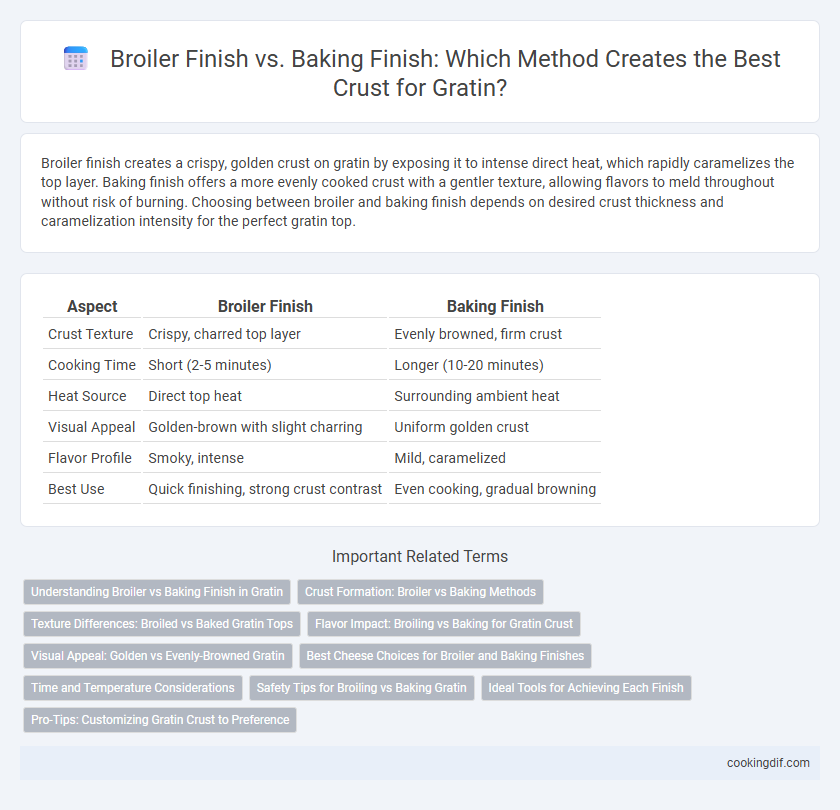Broiler finish creates a crispy, golden crust on gratin by exposing it to intense direct heat, which rapidly caramelizes the top layer. Baking finish offers a more evenly cooked crust with a gentler texture, allowing flavors to meld throughout without risk of burning. Choosing between broiler and baking finish depends on desired crust thickness and caramelization intensity for the perfect gratin top.
Table of Comparison
| Aspect | Broiler Finish | Baking Finish |
|---|---|---|
| Crust Texture | Crispy, charred top layer | Evenly browned, firm crust |
| Cooking Time | Short (2-5 minutes) | Longer (10-20 minutes) |
| Heat Source | Direct top heat | Surrounding ambient heat |
| Visual Appeal | Golden-brown with slight charring | Uniform golden crust |
| Flavor Profile | Smoky, intense | Mild, caramelized |
| Best Use | Quick finishing, strong crust contrast | Even cooking, gradual browning |
Understanding Broiler vs Baking Finish in Gratin
A broiler finish in gratin delivers a rapidly caramelized, crispy crust by exposing the dish to intense, direct heat, creating a richly browned top. Baking finish, by contrast, uses consistent oven heat to cook the entire gratin evenly, resulting in a softer, golden crust throughout. Understanding these methods helps achieve desired textures: broiler finish excels in crispiness, while baking finish ensures thorough cooking and a tender surface.
Crust Formation: Broiler vs Baking Methods
Broiler finish in gratin creates a rapidly browned, crispy crust due to intense direct heat, promoting Maillard reaction and caramelization on the surface. Baking finish forms a more evenly browned crust with gradual heat penetration, resulting in a thicker, less blistered top layer. Choosing broiler finish enhances crispiness and visual appeal, while baking offers uniform crust texture and thorough cooking.
Texture Differences: Broiled vs Baked Gratin Tops
Broiler finish on gratin creates a crisp, deeply browned crust with pronounced charred spots, offering a contrast between crunchy edges and creamy interior. Baking finish produces a uniformly golden crust with a gentler, evenly cooked texture, resulting in a softer, less intense surface crispness. Temperature control and proximity to heat source in broiling directly influence Maillard reaction, delivering more robust textural variation than steady oven baking.
Flavor Impact: Broiling vs Baking for Gratin Crust
Broiler finish creates a more intense, caramelized crust with a smoky, slightly charred flavor that enhances the savory notes of gratin. Baking finish results in a more even, golden crust with a milder, buttery taste, preserving the creamy texture beneath. Choosing broiling intensifies flavor complexity, while baking maintains balanced richness throughout the dish.
Visual Appeal: Golden vs Evenly-Browned Gratin
A broiler finish creates a golden, bubbly crust with distinct toasted spots, enhancing the gratin's visual appeal through striking contrast and texture. Baking finish yields an evenly-browned crust with uniform color and smooth surface, providing a classic, polished presentation. Choosing between the two impacts the gratin's aesthetic, with broiler offering dramatic highlights and baking delivering consistent warmth.
Best Cheese Choices for Broiler and Baking Finishes
Broiler finishes create a crisp, golden crust by exposing cheese to intense, direct heat, making high-moisture cheeses like mozzarella or fresh goat cheese ideal for melting without burning. Baking finishes gently brown the crust through indirect heat, favoring aged cheeses such as Gruyere, Parmesan, or aged cheddar for their robust flavor and ability to develop a rich, caramelized top layer. Selecting the right cheese based on finish method enhances texture and flavor profiles in gratins, with broiler finishes benefiting from mild, creamy cheeses and baking finishes excelling with sharp, flavorful varieties.
Time and Temperature Considerations
Broiler finish for gratin creates a rapidly browned, crisp crust by exposing the dish to intense, direct heat at around 500degF (260degC) for 2-5 minutes, significantly reducing total cooking time. Baking finish, on the other hand, requires longer exposure at lower temperatures between 350degF (175degC) and 400degF (200degC) for 20-30 minutes, allowing a more uniform crust development and even internal cooking. Selecting broiler finish optimizes crust texture quickly, while baking finish provides controlled heat for consistent doneness and flavor integration.
Safety Tips for Broiling vs Baking Gratin
Broiler finish on gratin creates a crisp, golden-brown crust quickly by applying intense direct heat, but extra caution is needed to prevent burning or flare-ups; always monitor closely and use oven mitts to avoid burns. Baking finish provides even browning and thorough cooking with less risk of sudden overcooking, making it safer for consistent results, especially in thicker gratins. For safety, keep the oven rack in the middle or upper position when broiling, never leave the oven unattended, and use heatproof cookware rated for high temperatures.
Ideal Tools for Achieving Each Finish
Achieving the perfect gratin crust requires different tools for broiler finish versus baking finish techniques. A broiler finish benefits from a high-quality broiler pan or oven-safe cast iron skillet to evenly expose the top to direct radiant heat, creating a crispy, golden crust quickly. In contrast, a ceramic or glass baking dish is ideal for baking finish, as it provides uniform heat distribution, ensuring a slow, even browning and creamy texture beneath the crust.
Pro-Tips: Customizing Gratin Crust to Preference
Broiler finish creates a rapidly browned, crispy gratin crust ideal for a crunchy texture, while baking finish produces a more evenly browned and slightly softer crust. To customize, use the broiler for 1-3 minutes at the end of baking to achieve a golden, bubbly top without burning. For enhanced flavor, sprinkle grated cheese like Gruyere or Parmesan before broiling to deepen the crust's richness and complexity.
Broiler finish vs baking finish for crust Infographic

 cookingdif.com
cookingdif.com